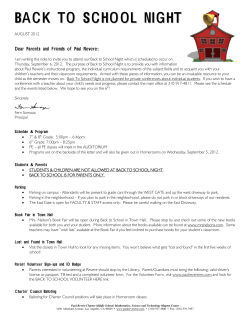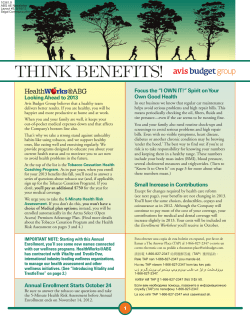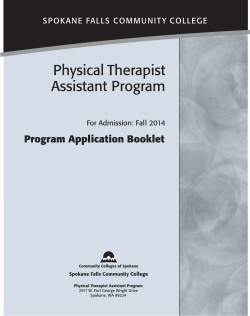
Medical Assistant Technology (MAS) 2 Locations Program Specific Information Packet
Sinclair Community College 444 West Third Street Dayton, Ohio 45402 Program Specific Information Packet Medical Assistant Technology (MAS) 2 Locations Dayton Campus 444 West Third Street Dayton, OH 45402 (937) 512-2973 (800) 315-3000 http://www.sinclair.edu/ Courseview Campus 5386 Courseview Drive Mason, OH 45040 (513) 339-1212 (800) 315-3000 http://www.sinclair.edu/courseview/ Program Director’s Office – Dayton Campus Building 2, room 122 (937) 512-3088 (800) 315-3000 Dear Prospective MAS Student: This packet contains the following information for your review: 1. Read the Health Sciences (HS) Applicant Information Packet for Degree Programs 2. Welcome Letter from Program Director 3. Commonly Asked Questions 4. Health Certificate and Immunization Requirements 5. Mental and Physical Requirements 6. Estimated Cost of Program 7. MAS Curriculum Please contact the MAS department for specific information regarding program enrollment or possible waiting lists for entry into the limited enrollment courses. 1 Revised 06/18/14 Step 1: Read the Health Sciences (HS) Applicant Information Packet for Degree Programs. This packet contains valuable information including a checklist for getting started. 2 Revised 06/18/14 Dear Prospective Medical Assistant Technology Student: Thank you for your interest in Sinclair Community College and the Medical Assistant Technology (MAS) Associate Degree Program. To become a MAS student, you must declare the program of study on your Sinclair admission application or, if you are already enrolled, contact an academic advisor to request MAS be added to your official record as your program of study. In either case, you will need to meet with an advisor to obtain your individualized “MAP” (My Academic Plan) which is a course schedule outline to get you aligned with completing the coursework within the MAS curriculum. The MAS curriculum consists of “open” and “limited enrollment” courses. Open and limited enrollment courses are noted on the curriculum sheet within this packet. Any student may register for “open” courses any term offered as long as the required prerequisites for those courses have been met. In order to register for “limited enrollment” courses, you must complete the prerequisite courses for cohort eligibility. The MAS Program must be completed within two years of beginning the limited enrollment courses. Students attending on a part-time basis should complete their support courses (those without a MAS prefix) prior to starting the limited enrollment courses. Entry point for admission for limited enrollment courses is Fall semester each year. Up to 40 applicants are permitted to register for the limited enrollment courses each year. As of December 2013, there is no “waiting list” for entry into the MAS limited enrollment courses. If you have any additional questions regarding the admission requirements, please contact the Medical Assistant Technology office at (937) 512-2973 or in room 2122. Sincerely, Judy Kronenberger, Ph.D., RN, CMA (AAMA) Professor / Program Director Medical Assistant Technology 3 Revised 06/18/14 Process for Entry into MAS Cohorts and Limited Enrollment Courses 1. Once a student has Medical Assistant Technology (MAS) added to his/her official transcript as a program of study, he/she is recognized as a MAS student as of that date. 2. The student’s transcript is reviewed by the MAS department for cohort eligibility (limited enrollment course eligibility). 3. Students who have completed the following requirements for cohort eligibility will be added to the limited enrollment course eligibility waiting list in the chronological order in which all of the following requirements have been satisfied. a. Declaration of MAS as his/her program of study b. Completion of developmental courses, if any, resulting from Placement Test Scores: DEV 0012 (reading), DEV 0032 or 0044 (writing), DEV 0024 (math) c. Completion of ALH 1101 or equivalent with a “C” or better d. Completion of BIO 1121 or equivalent with a “C” or better (BIO 1121 or equivalent may not be older than 5 years) e. Completion of MAT 1130 or MAT 1270 or equivalent with a “C” or better (MAT 1130 or MAT 1270 or equivalent may not be older than 10 years) f. Completion of SCC 1101 with a “C” or better g. Completion of the TEAS test (by June 1st of the year he/she will qualify to begin limited enrollment courses ) h. Grade point average of cumulative 2.0 or better 4. In the case that multiple students complete their requirements at the same time, students will be ranked according to the date MAS was recorded on the student’s record. a. If more than one student has the same recorded date, the students will be ranked according to the number of courses in the MAS curriculum they have successfully completed. 5. Students who have indicated MAS on their record and have not completed the requirements for cohort eligibility will continue to be monitored for eligibility. If no progress is made toward completion of the cohort eligibility requirements within one (1) year of becoming a MAS student, the student will be removed from the MAS program of study. a. Once removed, if the student is interested in the MAS program in the future, student must start over with seeing an academic advisor to begin the process again. 4 Revised 06/18/14 SINCLAIR COMMUNITY COLLEGE MEDICAL ASSISTANT TECHNOLOGY COMMONLY ASKED QUESTIONS 1. What is a Medical Assistant? A Medical Assistant is a nationally recognized multi-skilled professional who assists the physician in the medical office, clinic, or in a variety of other health care settings. 2. What kind of work does a Medical Assistant perform? Medical Assistants perform a wide range of duties in a physician’s practice requiring clinical and administrative skills. Some of the clinical duties performed by Medical Assistants include preparing patients for examinations and treatments, taking vital signs and medical histories, sterilizing instruments, performing diagnostic tests and basic laboratory procedures, and assisting the physician with examinations and minor office surgery. Some of the administrative responsibilities include scheduling and receiving patients, obtaining patient data, establishing and maintaining confidential medical records, working with electronic medical records, handling telephone calls, purchasing supplies, maintaining equipment, and assuming responsibility for daily office business. Additional duties include coding patient diagnoses/treatments for insurance reimbursement, paper and electronic insurance claim submissions, and maintaining office accounts, fees and collections. 3. What kinds of jobs are available to a Medical Assistant? According to the US Department of Labor, Bureau of Labor Statistics for 2010, (http://www.bls.gov/ooh/healthcare/medical-assistants.htm ): “Employment of medical assistants is expected to grow by 31 percent from 2010 to 2020, much faster than the average for all occupations. The growth of the aging baby-boom population will continue to spur demand for preventive medical services, which are often provided by physicians. As their practices expand, physicians will hire more assistants to perform routine administrative and clinical duties, allowing the physicians to see more patients. Assistants will likely continue to be used in place of more expensive workers, such as nurses, to reduce costs. In addition, an increasing number of group practices, clinics, and other healthcare facilities need support workers, particularly medical assistants, to do both administrative and clinical duties. Medical assistants work mostly in primary care, a steadily growing sector of the healthcare industry. Additional demand also is expected as a result of new and changing tasks for medical assistants as part of the medical team. As more and more physicians’ practices switch to electronic health records (EHRs), medical assistants’ job responsibilities will continue to change. Assistants will need to become familiar with EHR computer software, including maintaining EHR security and analyzing electronic data, to improve healthcare information.” Employment opportunities for Medical Assistants can be found in physician offices, urgent care centers, health maintenance organizations (HMOs), medical clinics, surgicare and ambulatory care centers. Medical Assistants may also be hired by insurance companies, state and federal health agencies, pharmaceutical companies, research centers, industrial clinics, health care consulting firms, or medical equipment/supply companies. The frequent changes in health care delivery will continue to stimulate the future need for qualified Medical Assistant personnel. 5 Revised 06/18/14 4. What is the earning potential? According to the US Department of Labor, Bureau of Labor Statistics for 2010, (http://www.bls.gov/ooh/healthcare/medical-assistants.htm#tab-5 ): “The median annual wage of medical assistants was $28,860 in May 2010. The median wage is the wage at which half the workers in an occupation earned more than that amount and half earned less. The lowest 10 percent earned less than $20,810, and the top 10 percent earned more than $40,190.” 2010 Median Pay: $28,860 per year or $13.87 per hour 5. Is this a degree program? Is this an accredited Medical Assisting program? Yes. Graduates receive an Associate Degree in Applied Science in Medical Assistant Technology from Sinclair Community College. Students who successfully complete the program are eligible to take the national exam for Certified Medical Assistant (CMA-AAMA). The Sinclair Community College Medical Assistant Technology Associate Degree program is accredited by the Commission on Accreditation of Allied Health Education Programs (www.caahep.org) upon the recommendation of the Medical Assisting Education Review Board (MAERB). Commission on Accreditation of Allied Health Education Programs 1361 Park Street Clearwater, FL 33756 727/210-2350 6. How long is the program? A full-time student who meets all of the requirements can complete the program in two years of education. This individual would place into college level course work as demonstrated by the placement scores on the Accuplacer Test and possess a current keyboarding (typing) skill of at least 20 words per minute. Part-time students will take longer to complete the program. Most of the Medical Assistant Technology (MAS) courses must be taken in sequence, but required non-MAS prefix courses may be completed before starting the MAS limited-enrollment courses. Prospective students are strongly advised to see a Health Sciences Academic Advisor as soon as possible in order to determine which route of study is best for their specific needs and lifestyle. An Advisor may be contacted for an appointment by calling (937) 512-3700 (room 11-346). 7. Are day and evening courses available? The majority of the required non-MAS prefix courses (such as English, math, biology, etc.) are offered during the day and evening, as well as distance learning via the web. The Medical Assistant (MAS prefix) courses are available during the day including the clinical experience courses with very limited flexibility. However, when possible, the Medical Assistant courses are also offered in the evening (subject to class size and instructor availability). 8. What types of learning experiences are included in this program? The minimal goal for this program is to prepare competent entry-level medical assistants in the cognitive (knowledge), psychomotor (skills), and affective (behavior) learning domains. Educational methods include classroom work, laboratory experience and clinical experience in various physician office and outpatient clinical settings. 6 Revised 06/18/14 9. Am I “too old” to start a new career or change careers? No! Many Medical Assistant students are typically 25-35 years old. Some are in the process of modifying or changing their careers and some are women who have decided to go to school now that their children are older. There is no age bias in employment hiring either. You are never too old to do something new and exciting! 10. When does the first Medical Assistant Technology course begin? Whether you are full or part -time, you may begin taking required non-MAS prefix classes during any semester of the year. Your first Medical Assistant (MAS prefix) course will be taken during the fall or spring semester for the academic year you are eligible to register in the limited-enrollment courses for the Program once you have completed all program prerequisite requirements. 11. May I take MAS courses out of sequence? Not generally. Once you begin the MAS limited enrollment courses, you must take all of the MAS courses in the semester that they are listed in the MAS curriculum. Many MAS courses are only offered once during each academic year in the term designated in the MAS curriculum. 12. What happens if I do poorly in a course? The MAS Program has strict guidelines regarding the satisfactory completion of all courses. You are required to achieve a minimum grade of “C” in all required courses. Less than a “C” grade in any of your non-MAS prefix courses will necessitate a counseling session with the MAS Chairperson. If you fail the same non-MAS prefix course twice, you will be dismissed from the MAS Program after counseling with the MAS Program Director. Less than a “C” grade in an MAS course will result in dismissal from the program after counseling with the MAS Program Director. The procedure for re-entering the MAS Program is outlined in the Health Sciences Reinstatement Policy, which is distributed and explained during the MAS orientation which is required when permitted to enroll in the limited enrollment//restricted MAS courses. 13. What will the program cost the student? Tuition and fees are published on the college website (http://www.sinclair.edu/services/bursar/cfs/index.cfm ). In addition to the “per credit hour” fee, there are laboratory fees assigned to courses with a lab/clinical component. The cost of required textbooks will vary depending on the term and number of courses for which you are registered. Students also bear the cost of the TEAS test, a lab coat, a uniform, a stethoscope, prior to entering the first clinical limited enrollment course. Students will also be responsible for the cost of a background check, a physical examination and immunizations prior to the practicum rotation. Please refer to the Estimated Cost of the Program information in this packet. 14. Is there financial aid available? Yes. There are several sources of financial assistance available. Please contact the Financial Aid Office at (937) 512-3000 or see the website at http://www.sinclair.edu/services/finaid/ for more information. 15. Are online classes available? Most non-MAS prefix courses are available online and a limited number of MAS courses are offered online. 7 Revised 06/18/14 Additional Program Information Uniforms & Equipment – Details will be provided during program orientation when planning limited enrollment course registration. Uniforms and shoes are required for this program. Students are required to have their own stethoscope. Practicum - Offsite Directed Practice Experience Students are required to complete two non-paid practicum experiences for the duration of two semesters during the second year of the program. o MAS 2220: Students will be assigned a site and complete a total 210 hours o MAS 2221: Students will be assigned to a site and complete a total 210 hours. Students may not be placed at the same practicum site for both semesters; however, an attempt will be made to place the student within a 20 mile radius of his/her home if possible. Required Health Certificate/Immunizations – Details will be provided during program orientation when planning for limited-enrollment course registration. A physical and immunizations will be required prior to starting the MAS 2220 practicum. A student health certificate must be completed by a physician prior to entry into the clinical setting. This includes a physical exam, tuberculin test, chest x-ray if the tuberculin test is positive, rubella immunization or proof of a titer for rubella, Tetanus and diphtheria adult vaccine (Td), and influenza. Due to the potential for clinical exposure to blood and other potentially infectious materials, the student may be at risk for acquiring Hepatitis B infection. Centers for Disease Control and Prevention (CDC) recommends that healthcare personnel who perform tasks that may involve exposure to blood or body fluids should receive a 3-dose series of hepatitis B vaccine. The following immunizations are suggested, but are not required at most clinical sites: varicella (chicken pox) titer. Required Background Checks – Details will be provided in the MAS Student Handbook and discussed during program orientation when planning for limited-enrollment course registration. Please refer to the HS Applicant Information Packet for more details. Federal and state background checks will be required for all students prior to beginning the first practicum course, MAS 2220. The cost of this background check must be paid by the student. The purpose of requiring background checks is to ensure the safety of patients, children, and the public during the practical experience in the medical assistant technology program. Requiring all medical assistant students to undergo a criminal background check prior to the practicum experience will also ensure that property, information, employees, other students of Sinclair Community College, and MAS clinical affiliates are reasonably safe from theft, injury or other unprofessional behavior from practicum students. Because the American Association of Medical Assistants (AAMA) prohibits anyone who has plead guilty to OR been convicted of a felony from sitting for the national certification examination to receive the CMA(AAMA) credential, a background check will also attempt to ensure that students will be eligible to complete their practicum experiences and become a certified medical assistant. 8 Revised 06/18/14 MENTAL AND PHYSICAL QUALIFICATIONS REQUIRED OF APPLICANTS TO MEDICAL ASSISTANT TECHNOLOGY Minimum acceptable mental and physical qualifications of an applicant for professional medical assisting include the following abilities: 1. Frequently work in a standing position and do frequent walking. 2. Lift and transfer patients up to six inches (6”) from a stooped position, then push or pull the weight up to three feet (3’). 3. Lift and transfer patients from a stooped to an upright position to accomplish exam tableto-chair and chair-to-exam table. 4. Physically apply up to ten pounds (10#) of pressure to bleeding sites, or in performing CPR. 5. Respond and react immediately to verbal instructions/requests and to auditory signals from monitoring equipment; perform auditory auscultation without impediment. 6. Physically perform up to a twelve-hour shift clinical laboratory experience. 7. Physically close and distance visual activities involving objects, persons, and paperwork, as well as discriminate depth and color perception. 8. Discriminate between sharp/dull and hot/cold when using both hands. 9. Perform mathematical calculations for medication preparation and administration. 10. Communicate effectively, both orally and in writing, using appropriate grammar, vocabulary, word usage, and interpersonal skills. Applicants to the Medical Assistant Technology Program are responsible for determining their own eligibility in light of these qualifications, for informing the college of any potential problem areas, and for identifying the Medical Assistant Technology Department any particular accommodations they may need. Students with disabilities are encouraged to register with the Educational Support Services - Disabilities and may utilize these services to determine appropriate accommodations. Students with disabilities who enter the program do so with the understanding that they will be expected to meet course requirements with any REASONABLE accommodation that may be provided by the college. 9 Revised 06/18/14 Estimated Cost of the Program For Montgomery County, Ohio residents: st Registration fee (one-time fee applied to 1 registration) Tuition: 60 credit hours x $99.03/per credit hour** Fees: Books: Test of Essential Academic Skills (TEAS) Physical/Immunizations: (Required for practicum /clinical rotations) Uniforms/equipment: Background check: CMA (AAMA) national examination Travel: (Required for practicum /clinical rotations) $20.00 5,941.80* 206.00 3,000.00 55.00 200.00 100.00 65.00 125.00 150.00 $9,862.80 For outside Montgomery County and inside Ohio: st $20.00 8,776.80* 206.00 3,000.00 55.00 200.00 100.00 65.00 125.00 150.00 $12,697.80 st $20.00 16,944.00* 206.00 3,000.00 55.00 200.00 100.00 65.00 125.00 150.00 $20,865.00 Registration fee (one-time fee applied to 1 registration) Tuition: 60 credit hours x $146.28/per credit hour** Fees: Books: Test of Essential Academic Skills (TEAS) Physical/Immunizations: (Required for practicum /clinical rotations) Uniforms/equipment Background check: CMA (AAMA) national examination Travel: (Required for practicum /clinical rotations) For outside of Ohio residents: Registration fee (one-time fee applied to 1 registration) Tuition: 60 credit hours x $282.40/per credit hour** Fees: Books: Test of Essential Academic Skills (TEAS) Physical/Immunizations: (Required for practicum /clinical rotations) Uniforms/equipment Background check: CMA (AAMA) national examination Travel: (Required for practicum/clinical rotations) * Tuition based on Summer 2014 rates ** There is an additional $7.50 per credit hour fee for online class 10 Revised 06/18/14 Limited enrollment Courses’ Prerequisites ALH 1101 – Introduction to Healthcare Delivery (2.0) BIO 1121 – Human Anatomy & Physiology I (3.0) MAT 1130 – Allied Health Math (3.0) ** SCC 1101 – Student Success (1.0) Total Credit Hours: 9.0 Revised: 9/18/13 Effective Fall 2013 Bldg. 2, Room 122 (937) 512-2973 MEDICAL ASSISTANT TECHNOLOGY PROGRAM CURRICULUM (MAS) SEMESTER COURSE MAS 1101 MAS 1102* BIO 1222 ENG 1101 HIM 1101 MAS 1103 MAS 1110 HIM 1201 ALH 1140 ALH 2201 MAS 2201 MAS 2210 MAS 2220*** COM 2206 PSY 1100 MAS 2202 MAS 2221 MAS Elective CREDIT LAB PREREQUISITES 3 2 2 3 2 0 3 2 0 0 ALH 1101; SCC 1101 BIO 1121, Chair Permission BIO 1121 DEV 0032 or equivalent DEV 0012 or equivalent 4 2 4 3 2 15 2 1 4 3 2 6 3 0 0 0 MAS 1102; MAT 1130 or 1270, MAS Majors MAS 1101; ENG 1101 HIM 1101, BIO 1121 BIO 1107 or BIO 1222 BIO 1121 or BIO 1141 2 1 1 3 3 6 3 14 0 0 ALH 1140; ALH 2202; MAS 1103, MAS Majors HIM 1201 MAS 1103, 1110, MAS Majors DEV 0012 and DEV 0032, or college English DEV 0012 or ENG 1101 Total 4 2 3 3 3 15 0 1 3 3 14 0 MAS 2201; MAS 2220; MAS 2210, MAS Majors MAS 2201; MAS 2210; MAS 2220 Total 1 3 3 7 FALL SEMESTER (14) Introduction to Medical Assisting Clinical Medical Assisting I Human Anatomy & Physiology II English Comp I Medical Terminology Total 3 3 3 3 2 14 SPRING SEMESTER (15) Clinical Medical Assisting II Administrative Medical Assisting I Introductory Medical Office Coding Fundamentals of Disease Processes Survey of Drug Therapy Total FALL SEMESTER (15) Clinical Medical Assisting III Medical Billing Specialist MAS Practicum I Interpersonal Communications General Psychology SPRING SEMESTER (7) MAS Capstone MAS Practicum II MAS Portfolio Elective LEC 51 Total Program Hours with Prerequisites = 60 * All non bolded courses are “limited enrollment” courses. Students must complete program prerequisites and receive permission from Program Director to enroll. ** MAT 1270 is acceptable in lieu of MAT 1130. *** Health certificate, immunizations, and background check must be completed prior to start of MAS 2220. Bolded courses can be taken prior to eligibility to register for limited enrollment courses in the MAS program 11
© Copyright 2025













